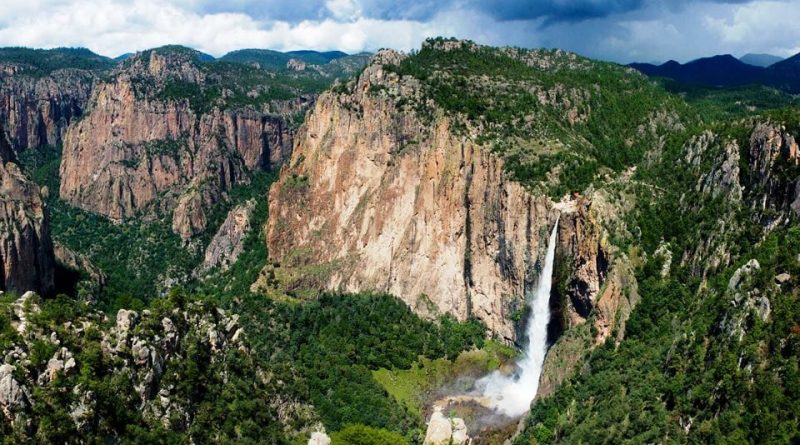Basaseachi Falls National Park
Basaseachi Falls National Park
Basaseachi Falls National Park is a national park located in the western part of the state of Chihuahua, in the heart of the Sierra Madre Occidental mountain range.
The park takes its name from Basaseachi Falls, the second highest waterfall in Mexico with a height of 246 meters. Basaseachi Falls flows into Candameña Canyon, carved by the Basaseachi River over millions of years. The park is known for its pine and oak forest, rock formations, and panoramic views from the high cliffs. The cliffs in the park reach an impressive height of 1,640 metres.
This national park was established on February 2, 1981, during the government of President José López Portillo, through an official decree promulgated in the Official Journal of the Federation, which granted the park an extension of 5,803 hectares, within which there is waterfall, and the forest it encompasses in and around the Barranca de Candameña.
Geography –
Basaseachi Falls National Park is located in the Sierra Madre Occidental subdivision known as Sierra Tarahumara, near the municipality of Ocampo, Chihuahua. The troubled topology was created by deep movements of tectonic plates that caused large fractures and widening rifts. The violent movement of the land gave rise to deep canyons and high mountains. Today’s topology has been modified over thousands of years by wind erosion and the Basaseachi River.
The pronounced vertical walls of Candameña Canyon can reach a height of 1,640 meters; Candameña Canyon is known as one of the deepest canyons in the Sierra Tarahumara. The park includes two rivers: the Duraznos River and the Basaseachi River; both rivers flow into Basaseachi Falls which flows into Candameña Canyon finally ending in the Candameña River.
Climate –
Basaseachi Falls National Park is located in the Mexican Sierra Madre mountains which, with their topography, have a huge impact on the local climate. If the Mexican coast enjoys a tropical and mild climate, the same cannot be said of the Sierra Madre mountain range. Here the climatic characteristics are very different, especially on the highest peaks and on the volcanoes which boast a climate that we could define as alpine.
To understand the altitude of some mountains we mention the Nevado de Toluca, in the south-west part of Mexico City. The mountain reaches 4300 meters high. The climate here is always very harsh, with maximum temperatures reaching 5° in April, the hottest month. The average temperature in January is around 2°.
Precipitation is concentrated in the months from May to October, with July and August recording the heaviest rainfall. Given the altitude, even in summer it is not unusual to find snow. On the highest volcanoes in Mexico, which reach and exceed 5000 meters, the glaciers are perennial.
Mexico is also a land of hurricanes and tropical cyclones, especially in coastal regions. Many of them form in the Gulf of Mexico and the Caribbean Sea. Generally, hurricanes can also reach the internal part of the country, but with less force and violence. The season in which these natural phenomena occur is usually between June and November. Cyclones, on the other hand, tend to form between August and October.
Flora –
Basaseachi Falls National Park has a great diversity in flora found in northern Mexico. One of the factors that allows the park to have such a wide variety of flora is due to the large number of microclimates present in the park due to the dramatic terrain. The park’s flora, like that found throughout the Sierra Madre Occidental mountain range, varies with altitude. Pine (Pinus) and oak (Quercus) species are usually found at an altitude of 2,000 meters above sea level. The park contains 92 species of conifers and 76 species of oaks. In the park we observe a large number of flora species of the following genera: Pinus, Quercus, Ficus, Vachellia, Ipomoea, Acacia, Lysiloma, Bursera, Vitex, Tabebuia, Sideroxylon, Cordia, Fouquieria, Pithecellobium.
Fauna –
Basaseachi Falls National Park is also home to a wide variety of wildlife including significant numbers of mammals, reptiles and birds. Mammals that can be found in the park include: Mexican fox squirrel (Sciurus nayaritensis), antelope hare (Lepus alleni), raccoon raccoon (Procyon lotor), hooded skunk (Mephitis macroura), wild boar (Sus scrofa) , the collared peccary (Pecari tajacu), white-tailed deer (Odocoileus virginianus), puma (Puma concolor). The three main species of reptiles present in the park are: Texas horned lizard (Phrynosoma cornutum), rock rattlesnake (Crotalus lepidus), black-tailed rattlesnake (Crotalus molossus).
There is a wide variety of birds observed in the park including: the Mexican jay (Aphelocoma ultramarina), the Steller’s jay (Cyanocitta stelleri), the acorn woodpecker (Melanerpes formicivorus), the canyon towhee (Pipilo fuscus), the funeral dove (Zenaida macroura), the billed hummingbird (Cynanthus latirostris), Montezuma’s quail (Cyrtonyx montezumae), mountain trogon (Trogon mexicanus), turkey vulture (Cathartes aura). The Trogon mexicanus is an endemic species found in the mountains of Mexico; it is considered an endangered species and has symbolic meaning for Mexicans.
The collection and identification of the fauna was carried out with the Wildlife staff of the Northern Forest Research Center (SARH), the species identified were considered reptiles, birds and mammals, these being the following:
The most conspicuous species in the area are the white-tailed deer (Odocoileus virginianus), the wild boar (Tayassu tajacu), the puma (Felis concolor), the raccoon (Procyon lotor), the striped skunk (Mephitis macroura), the gray skunk and red squirrels (Sciurus nayaritensis and S. albertibarbieri), the black-tailed hare (Lepus alleni).
Reptiles: chameleon (Phrynosoma sp.), collared lizard (Sceloporus jarrovi), rattlesnake (Crotalus lepidus), rattlesnake (Crotalus molossus).
Birds: bluebird (Cyanocitta stalleri), woodpecker (Melanerpes formicivorus), pipilo (Pipilo fuscus), red-tailed hawk (red-tailed hawk), funeral warbler (Zenaidura macroura), myrtle sucker (Cynanthus sp.), aura (Cathartes aura ), painted quail (Cyrtonyx montezumae).
Guido Bissanti


